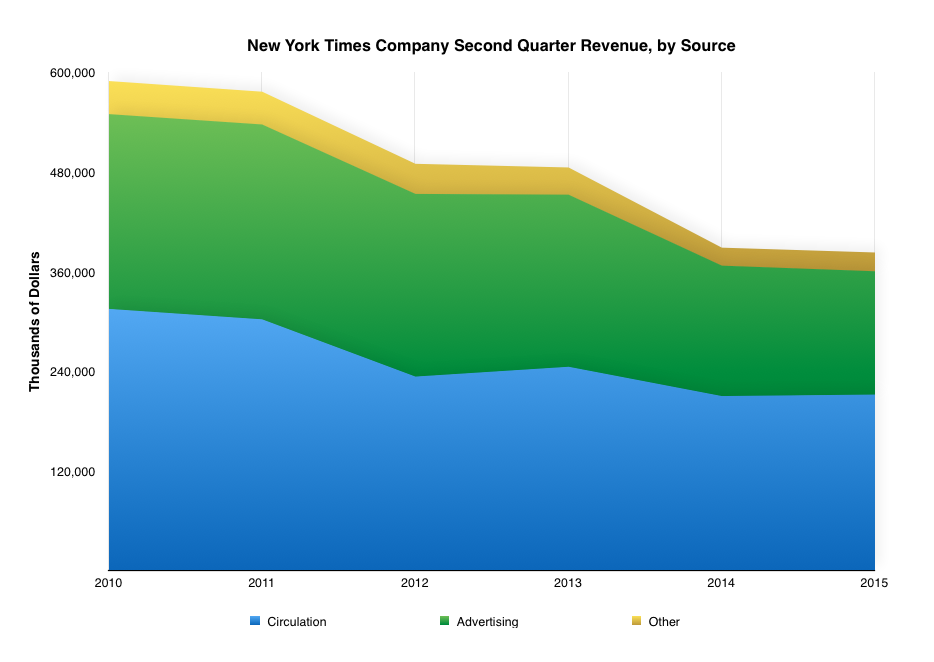Welcome to the Block Party

In a 1997 segment on the short-lived tech TV show The Site, host Soledad O’Brien sits at a bar in front of a laptop computer, talking to Dev Null, a full-scale human avatar with frosted fuchsia tips and a soul patch. Motion-captured from the show’s second host backstage, he swivels from side to side, arms swinging at their joints like a marionette, jaw moving up and down as a crude stand-in for a talking animation. The clip of their discussion of recent tech news is awkwardly edited, and a huge chunk of the conversation is cut out before the avatar breaks in with a choppy laugh. “It sounds like web heaven to me, but I guess that some of the content providers weren’t so thrilled about it,” he says.
“But if you strip banner ads out of most websites… isn’t advertising really how the web is supported, financially?” O’Brien replies.
Based on the air date, July 10th, it’s possible that they were talking about the then-newly trendy practice of turning off the “auto-load images” setting in the most popular web browser at the time, Netscape Navigator. The setting had existed since version 1.0 was released in 1994, but around late 1996 and early 1997, people began to realize that they could use the setting to prevent the internet’s burgeoning population of banner ads from loading on their favorite websites. (It’s also possible that they were discussing Internet Fast Forward, an early plugin for Netscape Navigator that blocked ads, cookies, and… blinking text.) Null answers O’Brien, “Oh basically, yeah, you’re undermining the entire infrastructure of the web, sure. But at least you don’t have to see commercials.”

Gawker has one of my favorite shamelessly aggressive pop-up ads on the internet. On any piece that seems to be getting a modicum of traffic, a silent, autoplaying video loads about ten seconds after the article does (preceded by thirty or so tracking scripts). There is a tiny link to dismiss the ad in the corner; if your cursor aim is not true, and you try to click, it will open you a second tab for whatever product it’s hawking. The videos last only a few seconds, which I used to spend being angry and impatient, but now I find it’s enough time for me to reflect on what I’m paying, and what I’m getting in return, and how long these transactions are really going to last. The ad can be skipped in 5, 4, 3, (take aim) 2, 1, and the link leaps out from under my mouse as I click. Another favorite: The other day, I took a break from reading an article on this website to check out some towels. I browsed the options, assessed the prices, and decided they weren’t right for me. I went back to the article I was reading. There, on the right side of the page rail, was an ad for the towels I was just looking at, from the same store. I didn’t even have to refresh the page.
Display ads on websites have only grown more aggressive in the last two years, taking up ever-expanding amounts of space, bandwidth, and attention. Interstitials that load as a separate page — or pop-ups, which load over the content and require a click to dismiss — are more popular than ever, especially on mobile; video ads that play automatically, too often with audio, have creeped onto more and more pages, which are themselves so engorged by the number and weight of ads that they take forever to load. And, to fill ad space on their sites, most publishers use third-party networks that often place tracking cookies on each user’s device in order to sop up information that can be used to serve new, more personalized ads, or to collect information that could be aggregated, repackaged, and sold to other marketing agencies.
A few months ago, the Reuters Institute for the Study of Journalism at the University of Oxford released its Digital News Report 2015. One of the products of the current online ad environment, according to the report, is “significant consumer dissatisfaction with online advertising, expressed through the rapid take up of ad blockers.” Another, recent report from Adobe and PageFair, a service that attempts to monetize users who block ads, estimated that sixteen percent of people in the US block ads. In some pockets of the internet, the rate of adblocking has always been high — according to Adobe and PageFair, 26.5 percent of people who visit gaming websites block ads, and at a tech website I used to work at, even five years ago, the rate hovered around thirty percent — but according to the Adobe report, usage of adblocking software has grown forty-eight percent in the US over the last year.
In June, Apple announced a new class of “content-blocking extensions” for iOS 9 and OS X that would allow developers to create extensions for Safari that “block cookies, images, resources, pop-ups, and other content,” like scripts for ad networks, before they even load. While ad-blocking extensions have been around for desktop browsers for well over a decade, it was a tiny declaration of a new era in the mobile internet. The response to one early content blocker in development for iOS 9, called Crystal, has been borderline rapturous, especially since the developer, Dean Murphy, revealed benchmarks showing that it makes pages load, on average, nearly four times faster using half as much bandwidth, all while blocking third-party scripts that would compromise privacy. The verdict on how mobile ad-blocking will affect publishing and advertising has been near–unanimous: “A reckoning is coming.”

The central philosophical dispute over ad-blocking goes something like this: Publishers have no right to force readers to be exposed to certain kinds of ads or allow numerous third parties to collect their information without a prior agreement; readers have no right to read or view content that they don’t pay for in one form or another, be it with money or data. What is not in dispute is that if ad-blocking becomes ubiquitous (and there’s nearly every reason to think that it will be!) it will be devastating for publications who derive much or all of their revenue from advertising — which comprises most of the professional publications on the internet. When Murphy first posted about “an hour with Safari Content Blocker in iOS 9,” he asked, rhetorically, “Do I care more about my privacy, time, device battery life & data usage or do I care more about the content creators of sites I visit to be able to monetise effectively and ultimately keep creating content? Tough question. At the moment, I don’t know.” (With the impending release of Crystal, it seems he’s resolved that tension.) When I spoke with Chris Aljoudi, lead developer on uBlock, an extension that tells users how many third-party scripts are active on a webpage, and asked how sites should sustain themselves if all of their ads are blocked, he replied, “I’m not an expert on whether it’s a business model, I don’t think we need to know as developers of a tool like this.” Even if they don’t have solutions, “users need to be able to control what they are forced to come across,” Aljoudi said, using the example of nytimes.com, a website for which no known mandate of visitation exists.

In 2014, the total operating cost of the New York Times Company was around 1.48 billion dollars (it is on track to shrink slightly this year), roughly three hundred million dollars of which goes toward “news gathering.” The Times Company is supported by a mix of revenue streams, of which “circulation” is the largest, followed by advertising. It recently hit a milestone of one million digital subscribers — at which it has “plateaued” — in addition to its roughly six hundred and twenty-five thousand print subscribers. Even though the Times has been on a forceful subscription drive, advertising still provides roughly forty percent of its revenue, according to its most recent quarterly earnings report. Unsurprisingly, given that it now reaches a hundred million unique visitors a month, digital advertising — particularly on mobile — is a growing percentage of that mix, but overall, in the quarter, advertising revenues are down 5.5 percent percent year-over-year, while circulation revenues are up less than one percent (breaking a multi-year slide, as you can see above); the end result is a net revenue decline of 1.5 percent. In other words, even the most important and widely respected newspaper in the world is nowhere close to being healthily monetized, especially not by the small number of people who pay for it.
The math is even starker for smaller publications and individual bloggers, who rely more heavily on display advertising — and who have already been battered by shifts in the advertising market; some longtime professional bloggers, like Heather Armstrong, have given up writing their blogs full-time. The Awl’s publisher Michael Macher told me that “the percentage of the network’s revenue that is blockable by adblocking technology hovers around seventy-five to eighty-five percent.” Currently, readers use an ad blocker on around twenty-five percent of all pageviews. Nicole Cliffe, one of the founders of The Toast, said that “adblocker is brutal for us. And people always break out the ‘Subscribers model! I donate twenty bucks a year!’ thing but it doesn’t add up.”
Indeed, Marco Arment, the creator of Instapaper, which copies content from websites and more often than not strips out advertising, and The Magazine, an iPad magazine that died after its subscriber base could no longer sustain it, suggests that “it has never been easier to collect small direct payments online, cutting out the advertising middlemen and selling directly to your true customers.” (Since this article was first published, Arment, who says he “make[s] most of my living from ads,” has released an adblocker for iOS.) But it is clear that most people do not want to pay with money — according to the Reuters report, despite the rise of paywalls over the last few years, only eleven percent of respondents in the US and six percent in the UK say that they have paid for online news in any capacity; the average amount paid per month per user was ten dollars (ten pounds in the UK).
The users of ad-blocking tools often view them as a force of natural selection: It is a way of letting publishers know that they love what they are selling (their content) but not what allows that content to exist (ads and trackers). Therefore, by blocking them, the argument goes, they are encouraging the system to evolve. “If advertisers would get the hint that people will surrender their eyeballs in a REASONABLE exchange, they can get what they want,” wrote one Reddit commenter in a thread about online advertising. “Like I said I never agreed to give up these impressions nor did the other users. Ads are their source of income but it doesn’t give them the right to force it down everyone’s throat,” wrote another. “Adapt or die” is a common refrain on the internet among people who do not like its prevailing business model. The other week, New York Times tech columnist Farhad Manjoo published a column on the state of adblocking, and suggested, as many people who participate stridently in arguments about adblocking do, that it has the potential to do good:
But in the long run, there could be a hidden benefit to blocking ads for advertisers and publishers: Ad blockers could end up saving the ad industry from its worst excesses. If blocking becomes widespread, the ad industry will be pushed to produce ads that are simpler, less invasive and far more transparent about the way they’re handling our data — or risk getting blocked forever if they fail…For better ads tomorrow, block ads today.
What will these “better” ads look like? One answer is that as publications transition to becoming direct content providers for the social networks and platforms whose audiences they are currently borrowing, like Facebook, Twitter, Snapchat, Google, perhaps Apple News (or Medium??)‚ many of the ads will be the same as before — placed in front of, beside, and between content — but sold and provided by the platform, rather than the publisher. Ad-blocking, insofar as it contributes to the decimation of advertising revenues, will hasten this exodus to the platforms.

And there is no way to block the ads shown to you by Facebook or Google or Twitter in their own apps, especially not on mobile. At that inflection point, the argument about how ad-blocking protects privacy by evading trackers also becomes largely irrelevant; there’s only one website I’ve found with a single third-party tracker, and one with zero trackers, according to the browser extension Ghostery: Facebook and Google, respectively. These are two of the largest marketing and advertising companies in the world, and they have to do virtually zero work in divining personal information from their users — in most cases, it’s just handed to them. Driving publishers to Facebook will not get rid of invasive trackers; it’s only declaring allegiance to the most comprehensive one, which has bought data from brokers with hundreds of millions of consumer profiles, and whose privacy policy doesn’t prevent it from selling users’ data, as long as it is anonymized (a process widely considered insufficient for privacy protection).
The other answer is that maybe these better ads simply don’t look like ads at all. The standard for an ad impression has gone from complex (the transaction requires a user’s click) to simple (must load on the page to register) to complex again (must load and have fifty percent of the ad by area be viewable for at least one second). Rather than playing this game, the fastest-growing media companies have figured out that the real way to make money does not involve display ads or ad exchanges at all, but native ads, which are designed to look and feel like the editorial — or at least unsponsored — content that it is next to; Ev Williams, the co-founder of Blogger, Twitter, and Medium, has espoused that today, “Native ads are the only thing that can work.” Outlets like BuzzFeed, Vice, Vox Media, The Atlantic Media, Condé Nast, and many, many others run “content studios” that develop advertising and sponsored campaigns for their business partners, often circulated through social media. While an extension can block a sponsored post on BuzzFeed’s front page, it can’t block it from your Facebook News Feed when somebody shares it, where it can reach millions of users either organically or via strategic paid placement. An extension can nix pre-rolls on YouTube, but BuzzFeed also develops video ads that are unaffected by adblocking, like a full-length video dedicated to Joe Dirt-themed lifehacks.
Perhaps the most famous example of these video’s is BuzzFeed’s “Dear Kitten” series for Friskies, segments which aired during the 2015 SuperBowl. One of these videos currently stands at 23.5 million views on YouTube. And that’s on the transparent side of things: Some sponsored content is not even well-marked. Refinery29 runs sponsored pieces that aren’t marked in any particular way on its front page; a business named LiquidSocial pays platform users to promote brands with zero disclosure. Both of these things seem to violate the FTC guidelines for online content sponsorship, but the guidelines are not proactively policed.
People who block ads are right; if this stuff doesn’t interest them it’s just as well they don’t see it. But when the ad is content being shared by people on a platform, it will be increasingly laser-targeted, and it won’t be blockable. When content and advertising and user profiles hoarded and traded by marketers are all inextricable, brand affiliations will precede users virtually everywhere they go. Desktop and mobile display ads as we know them (and block them) now will fade out, in the image of Buzzfeed, because they’ll be inferior. Blocking ads will lead to “better” ads, for some parties. Publishers that can sustain their own advertising arm can circulate sponsored content through one platform after another, using their internal data to inform their targeting strategies. Other publishers, smaller ones that hand over control of their business to platforms will get better-targeted ads, thanks to even tighter integration with the most comprehensive, all-knowing trackers on the internet; both publisher and advertisers will do better business reassured by the closed nature of apps and platforms that their ads are reaching the optimal audience who cannot escape them. And we can say for certain the pages will load very, very fast. For a while, anyway.
